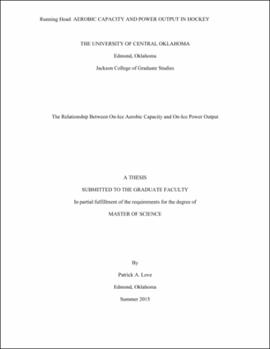| dc.contributor.advisor | Cowan, Jerel, | |
| dc.contributor.author | Love, Patrick A. | |
| dc.date.accessioned | 2020-07-13T19:06:36Z | |
| dc.date.available | 2020-07-13T19:06:36Z | |
| dc.date.issued | 2015 | |
| dc.identifier.other | (AlmaMMSId)9982440170802196 | |
| dc.identifier.uri | https://hdl.handle.net/11244/325243 | |
| dc.description.abstract | There is debate if a high aerobic capacity will improve recovery from repeated bouts of sprinting, which primarily taxes the anaerobic energy systems. The relationship between aerobic capacity and repeat sprint ability in ice hockey players is not well established; moreover, the relationships that have been examined involved off-ice testing protocols, which lack specificity to the ice hockey. Purpose: The purpose of this study was to examine the relationship between on-ice aerobic capacity (VO2peak and VIIT) and repeated on-ice sprint ability (RISA) via percentage of power output decrement (%DPO), and other measurements of on-ice power output (OPO). Methods: 11 male professional ice hockey players, recruited from an American Hockey League team, participated in two maximal effort on-ice tests. Aerobic capacity was tested via the 30-15 Intermittent Ice Test. Gas exchange was measured directly measured via an Oxycon portable O2 analyzer in four of the participants. OPO was measured via the Repeat Ice Skating Test. The relationship between these variables for nine of the participants was then analyzed via Pearson's correlational testing. Results: There was no significant relationship between VIIT or VO2peak to %DPO (r =-.036 and .197 respectively; p > .05) or any other measurement of RISA. Discussion: The results from this study suggest that aerobic capacity was not related to RISA. While the results were not statistically significant, likely due to a small sample size, the effect size for %DPO and aerobic capacity (VIIT and VO2peak) was small, indicating that the relationship was nearly negligible. Elite level ice hockey players may not have a better RISA resultant from a higher aerobic capacity. | |
| dc.rights | All rights reserved by the author, who has granted UCO Chambers Library the non-exclusive right to share this material in its online repositories. Contact UCO Chambers Library's Digital Initiatives Working Group at diwg@uco.edu for the permission policy on the use, reproduction or distribution of this material. | |
| dc.subject.lcsh | Maximal oxygen uptake | |
| dc.subject.lcsh | Hockey | |
| dc.subject.lcsh | Human locomotion | |
| dc.title | The relationship between on-ice aerobic capacity and on-ice power output | |
| dc.type | Academic theses | |
| dc.contributor.committeeMember | House, Paul | |
| dc.contributor.committeeMember | Fent, Darla | |
| dc.contributor.committeeMember | Endres, Dan | |
| dc.thesis.degree | M.S., Wellness Management - Exercise Science | |
| dc.subject.keywords | Kinesiology | |
| dc.subject.keywords | Biomechanics | |
| dc.subject.keywords | Physiology | |
| dc.subject.keywords | Aerobic Capacity | |
| dc.subject.keywords | Hockey | |
| dc.subject.keywords | On-Ice Testing | |
| dc.subject.keywords | Power Output | |
| dc.subject.keywords | Relationship between VO2 and repeated sprints | |
| dc.subject.keywords | Repeat Sprint Ability | |
| dc.identifier.oclc | (OCoLC)ocn947856262 | |
| uco.group | UCO - Graduate Works and Theses::UCO - Theses | |
| thesis.degree.grantor | Jackson College of Graduate Studies | |
